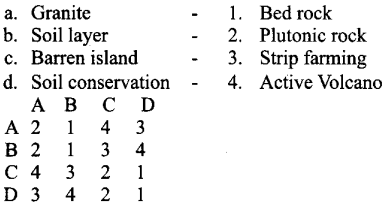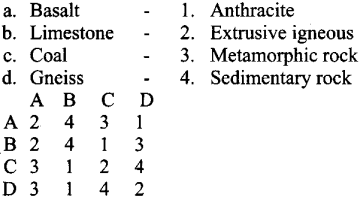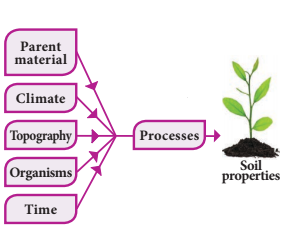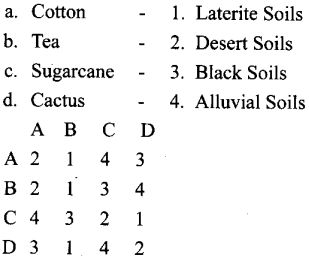Tamilnadu State Board New Syllabus Samacheer Kalvi 8th Social Science Guide Pdf Geography Chapter 4 Migration and Urbanisation Text Book Back Questions and Answers, Important Questions, Notes.
Tamilnadu Samacheer Kalvi 8th Social Science Solutions Geography Chapter 4 Migration and Urbanisation
Samacheer Kalvi 8th Social Science Migration and Urbanisation Text Book Back Questions and Answers
I. Choose the correct answer.
1. People move from ……………. to ……………. mainly in search of better jobs.
a) Rural to Urban
b) Urban to Rural
c) Hills to plains
d) Plains to hills
Answer:
a) Rural to Urban
2. A person moves from his own country to another country is known as ……………. .
a) Immigrant
b) Refugee
c) Emigrant
d) Asylum seeker
Answer:
c) Emigrant
3. The migration in search of fertile agricultural land is ……………. migration.
a) Rural to Rural
b) Rural to Urban
c) Urban to Rural
d) Urban to Urban
Answer:
a) Rural to Rural
![]()
4. War is one of the causes of human migration.
a) Demographic
b) Socio-cultural
c) Political
d) Economic
Answer:
c) Political
5. The main reason for the development of urbanisation in the pre-historic period was
a) Production of food grains
b) Domestication of cattle
c) Fishing
d) hunting
Answer:
b) Domestication of cattle
II. Fill in the blanks:
1. Urbanisation is determined by ……………. the number of factors.
Answer:
three
2. ……………. is the major push factor operating in rural areas.
Answer:
Migration
3. ……………. Metropolitan city in India has the second-highest urban population in the world.
Answer:
Delhi
4. The movement of a person based on his free will and desire to live in a better place is called ………… migration.
Answer:
Voluntary
5. In modem time urban growth was accelerated by the development of …………….
Answer:
New trade route
III. Match the following:
| 1. Emigration | a) In-migration |
| 2. Immigration | b) Outmigration |
| 3. Pull factor | c) Unemployment |
| 4. Push factor | d) Socio-cultural migration |
| 5. Marriage | e) Employment opportunity |
Answer:
| 1. Emigration | b) Outmigration |
| 2. Immigration | a) In-migration |
| 3. Pull factor | e) Employment opportunity |
| 4. Push factor | c) Unemployment |
| 5. Marriage | d) Socio-cultural migration |
IV. State whether the following statements are true or false.
1. Slums are generally found in cities.
Answer:
True
2. Mass migration is absent in the modem period.
Answer:
True
![]()
3. The process of urbanisation has a short history.
Answer:
False
4. Cities and towns are the major polluters of the environment.
Answer:
True
5. Transhumance is also referred to as seasonal migration.
Answer:
True
V. Consider the given statements and choose the correct option from the given ones.
1. Statement (A): Urbanisation is mainly due to the movement of people from rural to cities.
Reason (R): Rural to urban migration is not a predominant one.
a) A is correct but R is incorrect
Both A and R are incorrect
c) Both A and R are correct
d) A is incorrect and R is correct
Answer:
c) Both A and R are correct
VI. Answer the following questions in brief:
1. Define “Migration”.
Answer:
Migration has been defined differently by different experts. In general, migration is defined as the permanent or semi permanent change of residence of an individual or group of people over a significant distance. So, the term migration refers to the movement of people from one place to another.
![]()
2. What are the causes of rural to urban migration?
Answer:
The main causes are
- Searching for jobs
- Education
- Recreation facilities.
3. State the causes of ecological or natural migration.
Answer:
- Natural causes include volcanic eruption, mankind changed considerably.
- At this stage, people continued to move from one region to another in search of fertile land for cultivation.
4. Name any two pull factors of migration.
Answer:
- Employment opportunities
- Education.
5. What is Urbanisation?
Answer:
Urbanization refers to the process in which there is an increase in the proportion of the population living in towns and cities.
![]()
6. List out any four most populous cities in the world.
Answer:
Tokyo, Delhi, Mexico City, Sao Paulo.
VII. Answer the following questions in detail.
1. What are the different types of migration? Explain.
Answer:
Migration can be classified in several ways. They are:
1. Based on the movement associated with administrative limits.
(a) Internal Migration
(b) International Migration
2. Based on the willingness of the migrants for migration.
(a) Voluntary Migration
(b) Involuntary Migration
3. Based on the duration of stay of migrants in the place of destination.
(a) Short term Migration
(b) Long term Migration
(c) Seasonal Migration
1. Based on the movement associated with administrative limits.
(a) Internal Migration:
- The movement of people within a country is known as internal migration.
- Further internal migration is classified into four types. They are,
- Rural to Urban migration
- Urban to Urban migration
- Rural to Rural migration and
- Urban to Rural migration
(b) International Migration:
Migration that occurs across the national boundaries is known as international migration.
2. Based on the Willingness of the migrants for migration:
(a) Voluntary migration:
- If the migration takes place on perspus free will, initiative, and desire to live in a better place.
(b) Involuntary migration:
- If the migration takes place against the will of migrants is known as involuntary migration.
3. Based on the duration of stay of migrants in the place of destination:
(a) Short term migration:
- The migrants stay outside only for a short duration before returning to the place of origin.
(b) Long term migration:
- The migrants stay outside at least for a few years.
(c) Seasonal migration:
- Usually, a group of people migrates from their native places during a particular season and return after end of that season.
- Transhumance is another example of seasonal migration.
2. Explain in detail the various causes of migration?
Answer:
- The favourable factors which attract people towards a location are called pull factors.
- The unfavourable factors which make the people move out from a location are called push factors.
- Human migration can be categorized under five groups are
- Ecological or natural causes of migration
- Economic causes of migration
- Socio-cultural causes of migration
- Demographic causes of migration
- Political causes of migration.
3. Discuss the problems of urbanisation.
Answer:
1. Housing and Slums:
- There is a lack of space for housing and a marked reduction in the quality of housing in the urban areas due to increase in population.
2. Over Crowding:
- Over – crowding leads to unhealthy environment in the urban areas.
- It also the cause of many diseases and riots.
3. Water Supply, Drainage and Sanitation:
- No city has round a clock water supply in the world.
- The drainage situation is equally bad.
- The removal of garbage is a Himalayan task for urban local bodies.
4. Transportation and Traffic:
- The absence of planned and adequate arrangements for traffic and transport is another problem in urban centers.
- The increasing number of two-wheeler and cars make the traffic problem worse.
5. Pollution:
- Towns and cities are the major polluters of the environment.
- Several cities discharge their entire sewage and industrial effluents untreated into the nearby rivers. Industries in and around the urban centers pollute the atmosphere with smoke and toxic gases.
IX. Activities
1. List out and analyze the reason for the migration of people in your locality.
Answer:
People migrate for a number of reasons. The reasons and causes for migration would normally fall under these areas:
- Environmental – Better climate, calamities, and natural disasters are examples of environmental causes or reasons.
- Economic – Moving to find work or moving to follow a particular career path is an example of economic cause or reason.
- Cultural – Religious freedom and education is an example of cultural cause or reason.
- Political – Civil war or escaping from political persecution is an example of a political cause.
- Social – Moving for a better quality of life or moving closer to a family member or friend is an example of a social cause or reason.
2. Collect the pictures and information regarding the effects of urbanization and make an album.
Answer:
- Slums and Housing
- Overcrowding
- Transportation and traffic
- Pollution.
Samacheer Kalvi 8th Social Science Migration and Urbanisation Additional Important Questions and Answers
I. Choose the Correct answer.
1. The movement of an individual or group to the new country is termed as ………………..
a) Destination
b) Migration
c) Emigrant
d) Immigrant
Answer:
a) Destination
2. Migration is more in ………………. region of the world population.
a) Japan
b) Asia
c) Australia
d) Africa
Answer:
b) Asia
![]()
3. In 2017, ………………. was the largest country of origin of international migrants.
a) India
b) America
c) Delhi
d) Asia
Answer:
a) India
4. In ………………., the global urban population exceeded the global rural population.
a) 2005
b) 2006
c) 200
d) 2008
Answer:
c) 2007
5. During the beginning of the ………………. itself many cities were found near the Aegean sea.
a) 6th century
b) 7th century
c) 8th century
d) 5th century
Answer:
b) 7th century
6. In the ancient period the migration was mainly for ………………..
a) Environment
b) Health
c) Food
d) Place
Answer:
c) Food
7. The industrial revolution in the century accelerated the growth of towns and cities.
a) 17th
b) 18th
c) 19th
d) 20th
Answer:
c) 19th
![]()
8. In 1950, ………………. of the world’s population was urban.
a) 20%
b) 30%
c) 40%
d) 50%
Answer:
b) 30%
9. ………………. is the world’s Highest Population city.
a) Masco (Russia)
b) Shangai (China)
c) Delhi (India)
d) Tokyo (Japan)
Answer:
d) Tokyo (Japan)
10. Migration that occurs the national boundaries are known as
a) Internal migration
b) Voluntary migration
c) International migration
d) Involuntary migration
Answer:
c) international migration
II. Fill in the blank:
1. ………………. is a form of geographical mobility of population between a geographical unit to another.
Answer:
Migration
2. Climatic disasters are ………………. factors.
Answer:
push
3. The movement of people within a country is known as ………………..
Answer:
Internal migration
4. If the migration takes place against the will of migrants is known as ………………..
Answer:
Involuntary migration
5. The migration of agricultural workers during Saving sources is known as ………………..
Answer:
Seasonal migration
6. ………………. is another example of Seasonal migration.
Answer:
Transhumance
7. The number of international migrants in 2017 was ………………..
Answer:
258 million
8. Skilled people from economically backward countries move to developed Countries called ………………..
Answer:
Backwash effect
9. ………………. is the process in which there is an increase in the proportion of population living in towns and cities.
Answer:
Urbanisation
![]()
10. The excess production of ………………. was the major reason for urbanisation.
Answer:
foodgrains
11. The ………………. revolution in the 19th century accelerated the growth of towns and cities.
Answer:
industrial
12. Rapid rate of urbanisation results in the development of ………………..
Answer:
Slums
13. In ………………., ………………. regions migrants are predominantly men.
Answer:
Asia, Africa
14. The ………………. factors which attract people towards a location.
Answer:
favourable
15. ………………. is a natural cause of migration.
Answer:
Ecology
III. Match the following:
| 1. Natural cause | a) War |
| 2. Economic cause | b) Social Discrimination |
| 3. Socio-cultural Cause | c) Unemployment |
| 4. Political Cause | d) Scarcity of food |
Answer:
| 1. Natural cause | d) Scarcity of food |
| 2. Economic cause | c) Unemployment |
| 3. Socio-cultural Cause | b) Social Discrimination |
| 4. Political Cause | a) War |
IV. State whether the following statements are true or false.
1. The number of vehicles increase is not the cause of air pollution.
Answer:
False
2. The favourable factors which attract people towards a location.
Answer:
True
3. The movement of people within a country is known as internal migration.
Answer:
True
4. Migration develops both the areas of origin of migration and the areas of destination.
Answer:
False
![]()
5. After the 11th century, the European Countries, increased their overseas trade.
Answer:
True
V. Consider the given statements and choose the correct option from the given ones.
1. Statement: Migration may influence the occupational Structure of the Population of an area through this it will certainly affect the economy of the regions also.
Reason: Brain drain refers to the migration in which skilled people from economically backward countries move to developed countries in search of better opportunities,
a) A is correct but R is incorrect
b) Both A and R are incorrect
c) Both A and R are correct
d) A is incorrect and R is correct
Answer:
c) Both A and R are correct
2. Assertion: At the end of the 13th century, Paris London, Geneva, Milan, and Venice were the important cities found in Europe.
Reason: The European countries increased their overseas trade.
a) A is correct but R is incorrect
b) Both A and R are incorrect
c) Both A and R are correct
d) A is incorrect and R is correct
Answer:
c) Both A and R are correct
3. i) Migration that occurs across the national boundaries are known as Internal migration.
ii) If the migration takes place of a person’s free will is known as voluntary migration.
iii) The migration of agricultural workers during Sowing Seasons is known as Seasonal migration.
iv) The migration from rural areas to growing towns and cities mainly in search of employment, education, and recreation facilities.
a) i, iv correct
b) ii correct,
c) ii and iv correct
d) all are correct
Answer:
c) ii and iv correct
VI. Answer the following questions in brief.
1. What are the two factors of migration?
Answer:
- The favourable factors which attract people towards a location are called pull factors.
- The unfavourable factors which make the people to move out from a location are called push factors.
2. What is Backwash Effect?
Answer:
- Brain drain refers to the migration in which skilled people from economically backward countries move to developed countries in search of better opportunities.
- Eventually, this leads to backwardness in source regions. This is called a “backwash effect”.
3. What are the Environmental Consequences that occured during Migration?
Answer:
The overpopulation in urban areas leads to the pollution of air, water, and soil. Scarcity of drinking water, lack of space for housing, traffic congestions, and poor drainage are the common environmental problems that prevail in urban areas.
![]()
4. What are the causes of urbanisation?
Answer:
- Urbanisation is driven by three factors: natural population growth, rural to urban migration, and the reclassification of rural areas into urban areas.
- Present-day urbanisation includes changes in demographics, land cover, economic processes, and characteristics of geographic area.
5. What are the noted Prehistoric cities of the world?
Answer:
- Ur and Babylon in Mesopotamia
- Thebes and Alexandria in Egypt
- Athens in Greece
- Harappa and Mohenjodaro in India were noted prehistoric cities of the world.
6. What are the major cities in Africa?
Answer:
Major cities in Africa are Cairo, Nairobi, Mombasa, Bulawayo, Duala, Abidian, Logos, Accra, Addis Abba, Leopoldville, Luanda, Cape Town, Natal, Pretoria.
VII. Distinguish.
1. Short term migration and Long term migration.
| Short term migration | Long term migration |
| 1. In this kind of migration, the migrants stay outside only for a short duration before returning to the place of origin. | It is a kind of migration in which the migrants stay outside at least for a few years. |
| 2. The duration may be from a few days to a few months. | The migrants stayed a long time. |
VIII. Answer the following questions in detail.
1. Explain Pull factors and Push factors of migration.
| Pull factors | Push factors |
| 1. Least hazard-prone zones. | Hazard prone zones. |
| 2. Favourable climate. | Climate change (including extreme weather events). |
| 3. Abundance of natural resources and minerals (e. g. water, oil, uranium). | Crop failure and scarcity of food. |
| 4. Social Unification. | Social Discrimination. |
| 5. Under population. | Overpopulation. |
| 6. Political security. | War, civil, unrest. |
2. What are the Consequences of Migration?
a) Demographic consequences:
- It changes the age and sex composition of the population.
- Migration of females after their marriage leads to a decline in sex ratio in the source regions and increases in the sex ratio in the regions of destinations.
- The migration of male workers in search of jobs decreases the independent population of the source regions which increases the dependency ratio.
b) Social consequences:
- The migration of people from different regions towards an urban area leads to the formation of a plural society.
- It helps the people to come out of narrow mindedness and people become generous.
c) Economic consequences:
- The migration of more people from overpopulated to underpopulated regions results in the imbalance of the resource-population ratio.
- In some cases, the regions of over and under population may become the regions of optimum population.
- Migration may influence the occupational structure of the population of an area.
- Through this, it will certainly affect the economy of the regions also.
- Brain drain is a consequence of migration.
- Brain drain refers to the migration in which skilled people from economically backward countries move to developed countries in search of better opportunities
- Eventually, this leads to backwardness in source regions. This is called a “backwash effect”.
d) Environmental consequences:
- Large scale movement of people from rural to urban areas causes overcrowding in cities and puts heavy pressure on resources.
- It leads to the rapid growth of cities.
- The overpopulation in urban areas leads to the pollution of air, water, and soil.
- Scarcity of drinking water, lack of space for housing, traffic congestion, and poor drainage are the common environmental problems that prevail in urban areas.
- The lack of space for housing and the rising land cost lead to the formation of slums.























